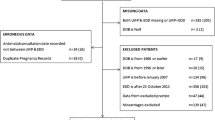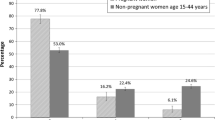Abstract
Background: For many regularly used drugs, evidence for safe use in pregnancy has not been established. Despite this, international studies have identified high levels of drug prescribing among pregnant women.
Objective: To investigate the patterns of prescribing of drugs to women who gave birth in Tayside, Scotland, in 2007.
Methods: Scottish maternity records were linked to dispensed prescribing data for all women who gave birth in Tayside in 2007. Drugs prescribed were coded according to the US FDA classification for risks of drugs in pregnancy. Patterns of prescribing were investigated during the 3 trimesters of pregnancy and the 3 months prior to conception.
Results: Prescribing in pregnancy was common, with 21 093 prescriptions dispensed to 3356 (85.2%) of the 3937 women. The most frequently prescribed drugs were antacids, antibacterials, oral iron, folic acid preparations and analgesics. Category A drugs (positive evidence of safety in pregnancy) and Category B drugs (some evidence of safety in pregnancy) accounted for 19.6% and 26.9% of all prescriptions dispensed, respectively. Prescribing of Category X drugs (evidence of risk to the fetus; use contraindicated in women who are or may become pregnant) during pregnancy was rare, with 112 prescriptions dispensed to 68 women (1.7%). Most of these were oral contraceptives or sex hormones. Prescribing of Category X drugs fell markedly during the first trimester and remained very low thereafter. Category D drugs (evidence of risk to the fetus but benefits of therapy may outweigh the potential risk) [432] were dispensed to 166 women (4.2%) during pregnancy. The most commonly prescribed Category D drugs were anxiolytics, nicotine replacement therapy and antiepileptic drugs. The frequency of prescribing of Category D drugs reduced in the third trimester. Prescribing of Category C drugs (insufficient evidence to know whether they are harmful) was common. Thirty percent of women received a total of 3641 Category C prescriptions, which accounted for 17.3% of all prescriptions issued during pregnancy. Prescribing of Category C drugs showed only a very modest decline during pregnancy. No FDA code was available for 4035 prescriptions issued (87 different items), the majority of which were for antacids and preparations for indigestion. More than 40% of women received such medications.
Conclusions: Prescribing of drugs during pregnancy was very common, but the levels of prescribing of drugs that are known to be harmful were low. Much of the prescribing was for drugs related to the pregnancy. While this study provides some evidence that primary-care prescribers in Tayside are prescribing potentially harmful drugs appropriately and with caution during pregnancy, safety data during pregnancy are unavailable for many drugs that are commonly prescribed.







Similar content being viewed by others
References
Engeland A, Bramness JG, Daltveit AK, et al. Prescription drug use among fathers and mothers before and during pregnancy: a population-based cohort study of 106,000 pregnancies in Norway 2004–2006. Br J Clin Pharmacol 2008; 65: 653–60
Gagne JJ, Maio V, Berghella V, et al. Prescription drug use during pregnancy: a population-based study in Regione Emilia-Romagna, Italy. Eur J Clin Pharmacol 2008; 64: 1125–32
Bakker MK, Jentink J, Vroom F, et al. Drug prescription patterns before, during and after pregnancy for chronic, occasional and pregnancy-related drugs in the Netherlands. BJOG 2006; 113: 559–68
Riley EH, Fuentes-Afflick E, Jackson RA, et al. Correlates of prescription drug use during pregnancy. J Womens Health 2005; 14: 401–9
Schirm E, Meijer WM, Tobi H, et al. Drug use by pregnant women and comparable non-pregnant women in the Netherlands with reference to the Australian classification system. Eur J Obstet Gynecol Reprod Biol 2004; 114: 182–8
Andrade SE, Gurwitz JH, Davis RL, et al. Prescription drug use in pregnancy. Am J Obstet Gynecol 2004; 191: 398–407
Egen-Lappe V, Hasford J. Drug prescription in pregnancy: analysis of a large statutory sickness fund population. Eur J Clin Pharmacol 2004; 60: 659–66
Lacroix I, Damase-Michel C, Lapeyre-Mestre M, et al. Prescription of drugs during pregnancy in France. Lancet 2000; 356: 1735–6
Shehata HA, Nelson-Piercy C. Drugs in pregnancy: drugs to avoid. Best Pract Res Clin Obstet Gynaecol 2001; 15: 971–86
Koren G, Pastuszak A, Ito S. Drugs in pregnancy. N Engl J Med1998; 16: 1128–1
Little BB. Drugs and pregnancy: a handbook. London: Hodder Arnold, 2007
Webster WS, Freeman JA. Prescription drugs and pregnancy. Expert Opin Pharmacother 2003; 4: 949–61
Weiner CP, Buhimschi C, Swaan P. Drug-prescribing challenges during pregnancy. Curr Obstet Gynaecol 2005; 15: 157–65
Mitchell AA. Systematic identification of drugs that cause birth defects: a new opportunity. N Engl J Med 2003; 349: 2556–9
Evans JMM, McDevitt DG, MacDonald TM. The Tayside Medicines Monitoring Unit (MEMO): a record-linkage system for pharmacovigilance. Pharmaceut Med 1995; 9: 177–84
British National Formulary. London: BMJ Group and RPS Publishing, 2007
Office of the Chief Statistician. Scottish index of multiple deprivation 2004: summary technical report. Edinburgh: Scottish Executive, 2004 [online]. Available from URL: http://www.scotland.gov.uk/library5/society/siomd.pdf [Accessed 2010 May 4]
ISD Scotland. Health and social care data dictionary [online]. Available from URL: http://www.datadictionaryadmin.scot.nhs.uk/isddd/1733.html [Accessed 2010 May 4]
Department of Health and Human Services, Food and Drug Administration. Content and format of labeling for human prescription drug and biological products; requirements for pregnancy and lactation labeling. Fed Regist 2008; 73: 30831–68
Colvin L, Slack-Smith L, Stanley FJ, et al. Pharmacovigilance in pregnancy using population-based linked data-sets. Pharmacoepidemiol Drug Saf 2009; 18: 211–25
Briggs GG, Freeman RK, Yaffe SJ. Drugs in pregnancy and lactation: a reference guide to fetal and neonatal risk. 7th ed. Philadelphia (PA): Lippincott, Williams and Wilkins, 2005
Physicians’ desk reference. 58th ed. Montvale (NJ): Thomson PDR, 2004
Spratto GR, Woods AL. PDR nurse’s drug handbook. Montvale (NJ): Thomson PDR, 2006
Drugs.com. Drug information online, 2000–2009 [online]. Available from URL: http://www.Drugs.com [Accessed 2010 May 4]
Lee E, Maneno MK, Smith L, et al. National patterns of medication use during pregnancy. Pharmacoepidemiol Drug Saf 2006; 15: 537–45
Wen SW, Yang T, Krewski D, et al. Patterns of pregnancy exposure to prescription FDA C, D and X drugs in a Canadian population. J Perinatol 2008; 28: 324–9
Andrade SE, Raebel MA, Morse AN, et al. Use of prescription medications with a potential for fetal harm among pregnant women. Pharmacoepidemiol Drug Saf 2006; 15: 546–54
Cooper WO, Hickson GB, Ray WA. Prescriptions for con-traindicated category X drugs in pregnancy among women enrolled in TennCare. Paediatr Perinat Epidemiol 2004; 18: 106–11
Hardy JR, Leaderer BP, Holford TR, et al. Safety of medications prescribed before and during early pregnancy in a cohort of 81,975 mothers from the UK General Practice Research Database. Pharmacoepidemiol Drug Saf 2006; 15: 555–64
Malm H, Martikainen J, Klaukka T, et al. Prescription of hazardous drugs during pregnancy. Drug Saf 2004; 27: 899–908
Olesen C, Sørensen HT, de Jong-van den Berg L, et al. Prescribing during pregnancy and lactation with reference to the Swedish classification system: a population-based study among Danish women. Acta Obstet Gynecol Scand 1999; 78: 686–92
De Vigan C, De Walle HE, Cordier S, et al. Therapeutic drug use during pregnancy: a comparison in four European countries. OECM Working Group. Occupational Exposures and Congenital Anomalies. J Clin Epidemiol 1999; 52: 977–82
Anderson S, Bradshaw P, Cunningham-Burley S, et al. Growing up in Scotland: a study following the lives of Scotland’s children. Edinburgh: Scottish Centre for Social Research and the Centre for Research on Families and Relationships, 2007 [online]. Available from URL: http://www.scotland.gov.uk/Resource/Doc/163083/0044329.pdf [Accessed 2010 May 4]
Haramburu F, Miremont-Salamé G, Moore N. Good and bad drug prescription in pregnancy. Lancet 2000; 356: 1704
Author information
Authors and Affiliations
Corresponding author
Rights and permissions
About this article
Cite this article
Irvine, L., Flynn, R.W., Libby, G. et al. Drugs Dispensed in Primary Care During Pregnancy. Drug-Safety 33, 593–604 (2010). https://doi.org/10.2165/11532330-000000000-00000
Published:
Issue Date:
DOI: https://doi.org/10.2165/11532330-000000000-00000




